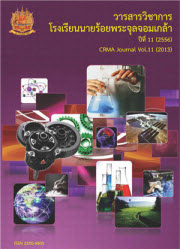ชุดข้อมูลแบบบูรณาการเพื่อการจัดการภัยแล้งของลุ่มนาชี
Main Article Content
บทคัดย่อ
ภัยแล้งเป็นภัยธรรมชาติประเภทหนึ่งที่เกิดขึ้นเป็นประจำทุกปี โดยเฉพาะในภาคตะวันออกเฉียงเหนือซึ่งส่งผลกระทบต่อการดำรงชีวิตของประชาชนและก่อให้เกิดปัญหาการขาดแคลนน้ำเพื่อการเกษตรกรรมและอุตสาหกรรม ลุ่มน้ำชีเป็นลุ่มน้ำที่มีความสำคัญอย่างยิ่งในการพัฒนาเศรษฐกิจและสังคมของภาคตะวันออกเฉียงเหนือและอยู่ในความสนใจของนักวิชาการ นักวิจัย และผู้เชี่ยวชาญในการตรวจสอบและควบคุมคุณภาพน้ำและปริมาณน้ำที่อาจจะส่งผลกระทบกับประชาชนรวมไปถึงภาคเกษตรกรรมและอุตสาหกรรม ด้วยเหตุที่น้ำเป็นทรัพยากรที่มีความสำคัญยิ่ง การตัดสินใจเกี่ยวกับทรัพยากรน้ำจึงเป็นเรื่องที่มีความสำคัญด้วยเช่นกัน การตัดสินใจที่ดีจำเป็นต้องอาศัยสารสนเทศที่ดีและมีคุณภาพ โดยเฉพาะอย่างยิ่งสารสนเทศที่ผ่านการวิเคราะห์ กลั่นกรองและประเมินผลด้วยวิธีการทางวิทยาศาสตร์ จากการศึกษา พบว่า ยังขาดการศึกษาและวิเคราะห์สารสนเทศที่จำเป็นสำหรับการจัดการทรัพยากรน้ำของลุ่มน้ำชี สารสนเทศมีอยู่กระจัดกระจายในหลายหน่วยงานที่เกี่ยวข้อง มีการจัดเก็บที่แยกจากกัน ชุดข้อมูลมีความซ้ำซ้อนกัน และแตกต่างกันไปตามบทบาทหน้าที่ของหน่วยงาน และความรู้เกี่ยวกับการจัดการทรัพยากรน้ำของลุ่มน้ำชี ส่วนหนึ่งเป็นความรู้ที่ฝังลึก (Tacit Knowledge) ของผู้เชี่ยวชาญซึ่งเป็นนักวิจัย และนักวิชาการ ซึ่งปรากฏว่าในประเทศไทยยังขาดการนำความรู้จากผู้เชี่ยวชาญมาบูรณาการกับสารสนเทศที่มีอยู่เพื่อทำให้การจัดการทรัพยากรน้ำของลุ่มน้ำชีมีความครอบคลุมและถูกต้องมากขึ้น
การวิจัยครั้งนี้เป็นการวิจัยเอกสารและการวิจัยเชิงคุณภาพ โดยผู้วิจัยได้ประยุกต์ใช้แนวคิด Knowledge Acquisition Approach (Liou, 1990) เพื่อรวบรวมและจัดเก็บความรู้โดยการสัมภาษณ์ผู้เชี่ยวชาญด้านวิศวกรรมสิ่งแวดล้อม วิศวกรรมทรัพยากรน้ำและสารสนเทศภูมิศาสตร์ จำนวน 10 คน และนักวิชาการจากหน่วยงานภาครัฐที่มีหน้าที่รับผิดชอบเกี่ยวกับการจัดการทรัพยากรน้ำของลุ่มน้ำชี จำนวน 7 คน ผู้เชี่ยวชาญได้มีส่วนร่วมในกระบวนการพัฒนาขอบเขตความรู้ จัดหมวดหมู่ความรู้ เพื่อออกแบบชุดข้อมูลแบบบูรณาการ (Integrated Dataset) ที่จำเป็นต่อออกแบบระบบสารสนเทศเพื่อสนับสนุนการตัดสินใจในการจัดการภัยแล้งของลุ่มน้ำชี
ผลการวิจัย พบว่า ชุดข้อมูลแบบบูรณาการเพื่อการจัดการภัยแล้งของลุ่มน้ำชีที่ได้ออกแบบการจัดหมวดหมู่ความรู้ ตามแนวคิดและขั้นตอนการจัดการภัยแล้งในรูปแบบที่เป็นโครงสร้างลำดับชั้น แบ่งออกเป็น 3 ขั้นตอนหลัก ดังนี้ 1) การวางแผนก่อนเกิดภัยแล้ง (Planning) ประกอบด้วยชุดข้อมูลเพื่อการคาดการณ์ (Forecast) การเฝ้าระวัง (Monitoring) และการวางแผน (Planning) 2) การปฎิบัติขณะเกิดภัยแล้ง (Response) ประกอบด้วยชุดข้อมูลเพื่อการแจ้งเตือน (Alert) และการให้ความช่วยเหลือ(Emergency) และ 3) ชุดข้อมูลเพื่อการฟื้นฟูหลังเกิดภัยแล้ง (Recovery)
Article Details
ผลงานที่ได้รับการตีพิมพ์ ถือเป็นลิขสิทธิ์ของวารสารฯ
References
ชรัตน์ มงคลสวัสดิ์ และคณะ, 2550.ระบบฐานข้อมูลพื้นที่เสี่ยงภัยแล้งภาคตะวันออกเฉียงเหนือ = GIS database: drought risk area in North-East Thailand. ขอนแก่น : ศูนย์ภูมิสารสนเทศเพื่อการพัฒนาภาคตะวันออกเฉียงเหนือมหาวิทยาลัยขอนแก่น.
เฉลิม ชัยพาวัฒนา, 2546. รายงานโครงการวิจัยปีที่1: โครงการการศึกษาพื้นที่ที่เสี่ยงภัยน้ำท่วมของลุ่มน้ำชีโดยระบบสารสนเทศภูมิศาสตร์. ภาควิชาวิศวกรรมโยธาคณะวิศวกรรมศาสตร์มหาวิทยาลัยขอนแก่น.
ปราณี ว่องวิทวัส, 2532.ฝนในประเทศไทย. กองภูมิอากาศกรมอุตุนิยมวิทยา. กรุงเทพฯ.
รัศมี สุวรรณวีระกำธร, 2550.แนวทางการวิเคราะห์ความแห้งแล้งด้วยระบบสารสนเทศภูมิศาสตร์: กรณีพื้นที่ศึกษาลุ่มน้ำเชิญ. ดุษฎีนิพนธ์สาขาวิชาปฐพีศาสตร์บัณฑิตวิทยาลัยมหาวิทยาลัยขอนแก่น.
วิเชียร ปลื้มกมล, 2550. แบบจำลองการจัดการน้ำในลุ่มน้ำชี = Water management model in Chi Basin. ภาควิชาวิศวกรรมเกษตรคณะวิศว-กรรมศาสตร์มหาวิทยาลัยขอนแก่น.
สถาบันสารสนเทศทรัพยากรน้ำและการเกษตร, 2551. ข้อมูลพื้นฐานของลุ่มน้ำชี [Online] http://www.haii.or.th/wiki/index.php/ลุ่มน้ำชี.
สำนักงานนโยบายและแผนสิ่งแวดล้อม, 2539. โครงการศึกษาเพื่อกำหนดพื้นที่ที่เสี่ยงต่อการเกิดอุทกภัยและภัยธรรมชาติในเขตลุ่มน้ำภาคตะวันออกเฉียงเหนือ. กระทรวงวิทยาศาสตร์เทคโนโลยีและสิ่งแวดล้อม. กรุงเทพฯ.
Andreu, J., J. Ferrer-Polo, M.A. Perez, and A. Solera, 2009. Decision Support System for Drought Planning and Management in the Jucar River Basin, Spain. 18th World IMACS/MODSIM Congress [Online] http://metronu.ulb.ac.be/imacs/cairns/I3/andreu_a.pdf.
Ames, D. P., Horsburgh, J. S., Cao, Y., Kadlec, J., Whiteaker, T., & Valentine, D., 2012. Hy-droDesktop: Web services-based software for hydrologic data discovery, download, visualization, and analysis.Environmental Modelling & Software, 37:146–156.
Bora Beran and Michael Piasecki, 2009. Engineering new paths to water data. Computers & Geosciences, 35(4):753-760.
Jung, I.-W. Chang, H., Lafrenz, M., Pan, Y., Yeakley, A., Shandas, V., Moradkhani, H., and Jay, D., 2011. Water Resource Vulner-ability in the Columbia River Basin.Pacific Northwest Climate Science Conference, Seattle, September 14.
Knutson C.L., Wilhite D.A., 2008. Drought management planning: conditions for suc-cess. In :López- Francos A. (ed.). Drought management: scientific and technological innovations. CIHEAM, 2008 [Online] http://om.ciheam.org/article.php?IDPDF=800434.
Liou. Y. I., 1990. Knowledge acquisition: issues, techniques, and methodology. In Elias M. Awad (Ed.)Proceedings of the 1990 ACM SIGBDP conference on Trends and directions in expert systems. New York, NY: ACM, 212-236.
Morgan, K., 2009.Understanding how data quality impacts decision quality. Research Triangle Institute, Washington, D.C.
Organization for Economic Co-operation and Development, 2010. The water challenge: OECD's response [Online] http://www.oecd.org/environment/resources/water.htm.
Payne, P. R. O., Mendonça, E. A., Johnson, S.B., & Starren, J. B., 2007. Conceptual knowledge acquisition in biomedicine: A methodological review. Journal of Bio-medical Informatics. 40 (5) :582–602.
United Nations, 2009. Conservation & Management of resources for development[Online] http://www.un.org/esa/dsd/ agenda21/res_agenda21_18.shtm.

